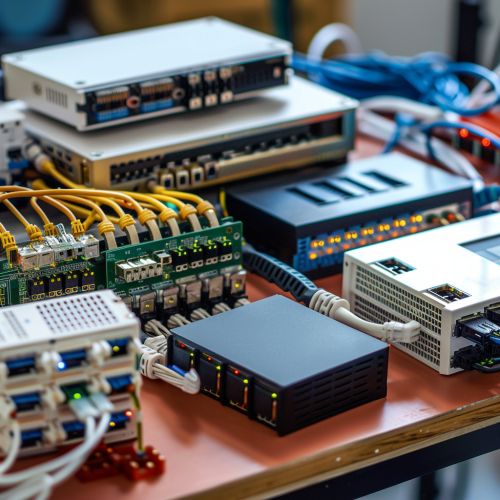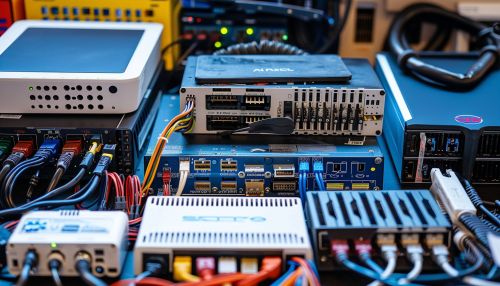Protocols: Difference between revisions
(Created page with "== Introduction == Protocols are a set of rules or procedures for transmitting data between electronic devices, such as computers. They ensure that data is sent, received, and interpreted correctly, enabling effective communication across various systems. Protocols are fundamental to the functioning of networks and the Internet, and they operate at different layers of the Open Systems Interconnection (OSI) model. == Types of Protocols == Protocols can be b...") |
No edit summary |
||
| Line 86: | Line 86: | ||
* [[Wireless Communication]] | * [[Wireless Communication]] | ||
[[Image:Detail-93087.jpg|thumb|center|Various network devices such as routers, switches, and cables arranged on a table.|class=only_on_mobile]] | |||
[[Image:Detail-93088.jpg|thumb|center|Various network devices such as routers, switches, and cables arranged on a table.|class=only_on_desktop]] | |||
== References == | == References == | ||
Latest revision as of 23:17, 21 June 2024
Introduction
Protocols are a set of rules or procedures for transmitting data between electronic devices, such as computers. They ensure that data is sent, received, and interpreted correctly, enabling effective communication across various systems. Protocols are fundamental to the functioning of networks and the Internet, and they operate at different layers of the Open Systems Interconnection (OSI) model.
Types of Protocols
Protocols can be broadly categorized based on their function and the layer of the OSI model they operate in. The primary types include:
Application Layer Protocols
Application layer protocols are used by software applications to communicate over a network. Examples include:
- HTTP: Used for transmitting web pages.
- FTP: Used for transferring files between computers.
- SMTP: Used for sending emails.
Transport Layer Protocols
Transport layer protocols ensure reliable data transfer between devices. Key examples are:
- TCP: Provides reliable, ordered, and error-checked delivery of data.
- UDP: Offers a simpler, connectionless service without guaranteed delivery.
Network Layer Protocols
Network layer protocols determine how data is routed across networks. Examples include:
- IP: Responsible for addressing and routing packets of data.
- ICMP: Used for diagnostic and error-reporting purposes.
Data Link Layer Protocols
Data link layer protocols manage the communication between adjacent network nodes. Examples include:
- Ethernet: A widely used protocol for local area networks (LANs).
- PPP: Used for direct communication between two network nodes.
Physical Layer Protocols
Physical layer protocols define the electrical and physical specifications for devices. Examples include:
- RS-232: A standard for serial communication.
- USB: A protocol for connecting peripherals to computers.
Protocol Design and Implementation
Designing a protocol involves defining the syntax, semantics, and timing of communication. Key considerations include:
Syntax
The syntax of a protocol refers to the structure and format of the data being exchanged. This includes the definition of message types, fields, and their encoding.
Semantics
Semantics define the meaning of each message type and field. This ensures that both the sender and receiver interpret the data consistently.
Timing
Timing rules specify the order and timing of message exchanges. This includes defining timeouts, retransmissions, and synchronization mechanisms.
Protocol Standards
Protocols are often standardized by international organizations to ensure interoperability. Key organizations include:
- IETF: Develops and promotes Internet standards, including the TCP/IP suite.
- ISO: Develops international standards, including the OSI model.
- IEEE: Develops standards for a wide range of technologies, including Ethernet and Wi-Fi.
Security Protocols
Security protocols are designed to protect data integrity, confidentiality, and authenticity. Examples include:
- SSL/TLS: Used to secure web communications.
- IPsec: Provides security for IP communications by authenticating and encrypting each IP packet.
- PGP: Used for securing email communications.
Protocol Analysis and Testing
Analyzing and testing protocols is crucial to ensure their reliability and performance. Techniques include:
Formal Verification
Formal verification uses mathematical methods to prove the correctness of protocols. This helps identify potential flaws and vulnerabilities.
Simulation
Simulation involves creating a virtual environment to test the behavior of protocols under various conditions. This helps evaluate performance and identify issues.
Conformance Testing
Conformance testing checks whether a protocol implementation adheres to its specification. This ensures interoperability between different implementations.
Future Trends in Protocol Development
The development of protocols continues to evolve with advancements in technology. Emerging trends include:
- 5G and 6G: New protocols are being developed to support the high-speed, low-latency requirements of next-generation mobile networks.
- IoT: Protocols are being designed to handle the unique challenges of IoT devices, such as low power consumption and limited processing capabilities.
- Quantum communication: Research is ongoing into protocols that leverage the principles of quantum mechanics for secure communication.
Conclusion
Protocols are essential for enabling communication between electronic devices. They operate at various layers of the OSI model and serve different functions, from ensuring reliable data transfer to securing communications. The design, standardization, and testing of protocols are critical to their effectiveness and interoperability. As technology advances, new protocols will continue to be developed to meet emerging needs and challenges.
See Also


